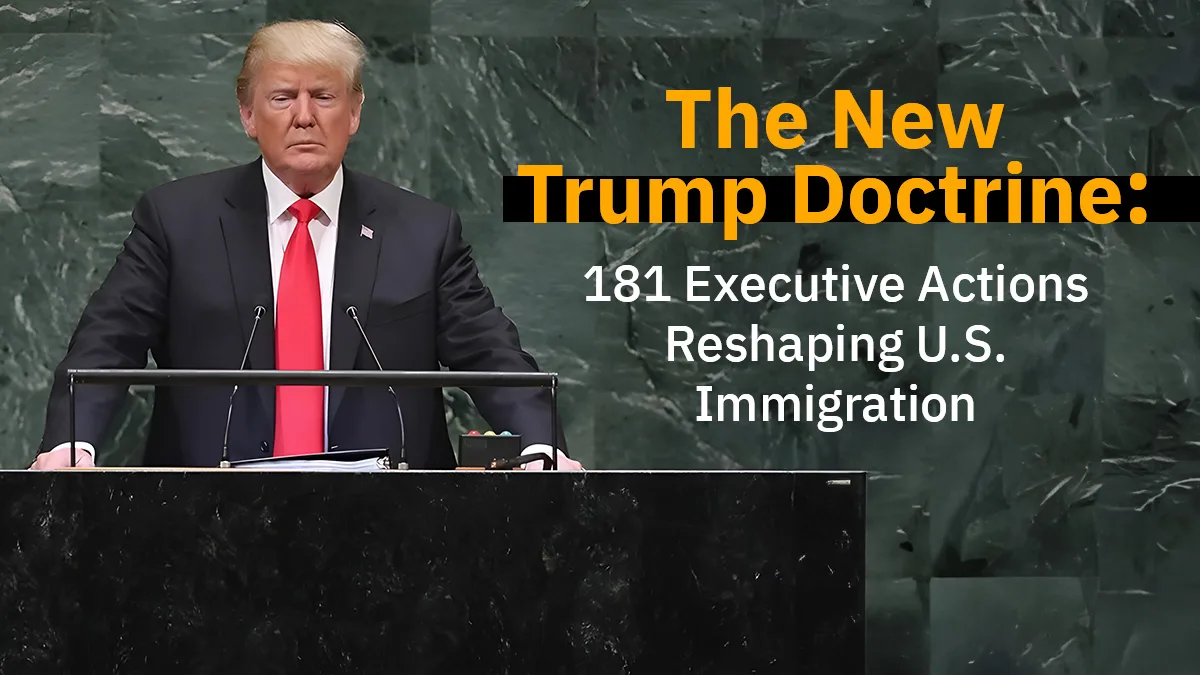The New Trump Doctrine: 181 Executive Actions Reshaping U.S. Immigration
By D. Kholoud Mahmoud

Between the American Dream and Border Security: An Impossible Equation
Between the dreams of millions and societal fears, between economic demands and national security pressures, the issue of immigration and border security represents one of the most complex equations facing policymakers in Washington. America, a nation built by immigrants which prides itself on its cultural diversity as a pillar of its soft power, now finds itself at a historic crossroads. For the first time since the 1960s, the country is witnessing a tangible decline in the number of arriving immigrants, from 53.3 million to 51.9 million in just a few months—a demographic shift that could reshape the population structure of the superpower.
Behind these numbers lies a complex human story, intertwined with fateful political decisions—from Biden’s asylum restrictions to 181 executive actions by Trump—along with human suffering at the border, economic aspirations to boost innovation, and security fears of border breaches. While immigrants constitute 38% of the science, technology, engineering, and math (STEM) workforce and crucially contribute to driving the economy, voices calling for tighter border surveillance and protection of American jobs are growing louder. This paradox presents America with an existential question: how does it balance its identity as a land of dreams with its responsibility to protect its borders?
A Deliberate Demographic Shift: Causes and Origins
The immigrant share of the total population has decreased to 15.4% from 15.8%. This decline did not happen by chance; it resulted from radical policy changes by both parties for several reasons:
· Major Political Shifts: New asylum restrictions imposed by President Biden in mid-2024, followed by 181 executive actions from President Trump during the first 100 days of his second term, have radically altered the landscape.
· Changing Origins Map: While Mexico remains the largest source of immigrants (11 million), South American countries like Venezuela, Colombia, and Cuba have emerged as new major sources, while the share of arrivals from Asia and Sub-Saharan Africa has declined.
· Evolving Legal Status: Data indicates that 46% of immigrants are now naturalized citizens, while over 6 million undocumented immigrants enjoy temporary protection from deportation.
The Border as a Laboratory: Policies and Consequences
The U.S. border has become a testing ground for unconventional policies and ideas, with officials announcing it is “safer” compared to the end of 2019, citing:
· Fewer Daily Attempts: Illegal crossing attempts have often fallen to less than a thousand per day.
· Increased Deportations: Deportation operations have escalated, exceeding 250,000 deportations in the past year.
· Technological Revolution: Adoption of advanced surveillance systems, AI for cargo screening, and biometric identification tools, reducing wait times and boosting supply chain efficiency.
In light of this, several unconventional proposals have been made to address the crisis, most notably calls for NATO intervention to help manage the border crisis, suggesting the alliance could be a platform for sharing lessons learned from allies’ experiences with so-called “managed migration.”
However, these policies have triggered serious regional repercussions:
· Criminal Adaptation: Pressure on smuggling networks has led these groups to adapt and change tactics.
· Rising Local Violence: Violence has intensified in Mexican border states like Tijuana and Nuevo Laredo.
· Strained Bilateral Relations: These policies have affected relations with neighboring countries, specifically Mexico.
The Economic Engine: The Indispensable Role of Immigrants
Despite the heated political debate, survey data reveals the pivotal role immigrants play in driving the U.S. economy through vital contributions to the workforce:
· Workforce Participation: Immigrants constitute 18.2% of the total labor force, filling critical gaps in multiple sectors.
· Leading Technological Innovation: Immigrants make up 38% of workers in STEM fields.
· Supporting the Health Sector: They represent 24% of healthcare workers.
· Entrepreneurship: Immigrants are 80% more likely to start a business compared to native-born Americans, accounting for 25% of all new businesses founded.
Internal Shifts and Future Scenarios
The geographic distribution of immigrants is undergoing significant changes. While they remain concentrated in traditional states like California (24%), Texas (11%), and New York (10%), they are increasingly moving to states like Georgia, North Carolina, Washington, and Colorado, which are experiencing the fastest growth rates of immigrant populations.
Despite the recent decline in numbers, immigration remains crucial for the country’s demographic and economic growth. Over 11 million immigrants arrived in the United States between 2020 and 2025, including more than 3 million in 2023 alone—the largest annual total ever recorded. These figures confirm that immigration will remain a central factor in shaping America’s demographic and economic future in the coming decades.
Conclusion: The Impossible Equation
The equation of immigration and border security in the United States remains impossible to solve—not for lack of solutions, but due to conflicting interests and priorities. While the numbers point to a historic decline in immigrant numbers for the first time since the 1960s, another equally important truth emerges: the American economy still depends critically on these new arrivals, especially in technology, healthcare, and entrepreneurship.
The current direction, despite successfully deporting over 250,000 immigrants and reducing daily crossing attempts, seems to treat the symptoms rather than the disease. Fundamental questions still await answers: Can America maintain its position as an economic superpower without the renewal brought by immigration? Will technology provide a magic bullet for a complex humanitarian crisis? How will current transformations affect the social fabric of the superpower over the next decade?
The successive political decisions, from Biden’s restrictions to Trump’s measures, may succeed in temporarily changing the demographic map of immigration and population, but they fail to provide a radical solution that reconciles the demands of security with the necessities of the economy. In the end, America is left with two difficult choices: either retain its identity as a land of dreams and opportunity, or transform into a fortified fortress that places security above all else.
